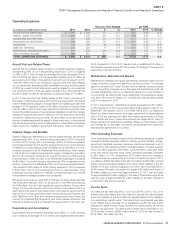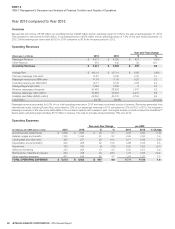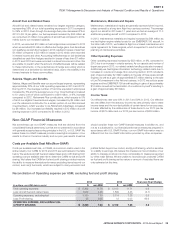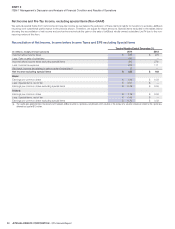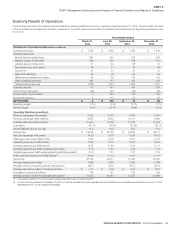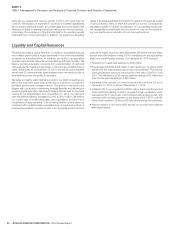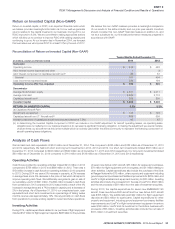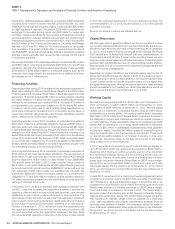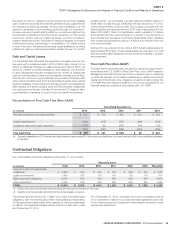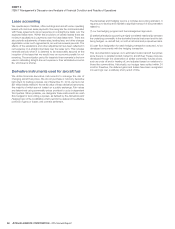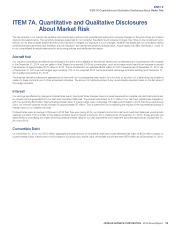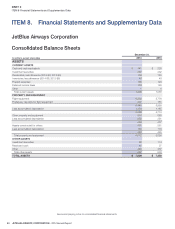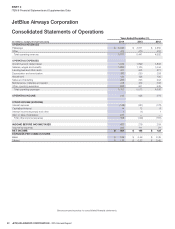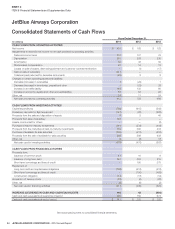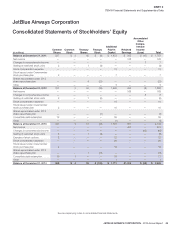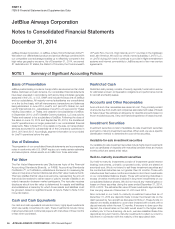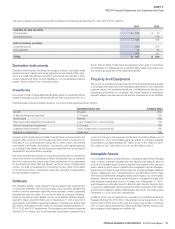JetBlue Airlines 2014 Annual Report Download - page 43
Download and view the complete annual report
Please find page 43 of the 2014 JetBlue Airlines annual report below. You can navigate through the pages in the report by either clicking on the pages listed below, or by using the keyword search tool below to find specific information within the annual report.
JETBLUE AIRWAYS CORPORATION-2014Annual Report 37
PART II
ITEM7Management’s Discussion and Analysis of Financial Condition and Results of Operations
Critical Accounting Policies and Estimates
The preparation of our consolidated financial statements in conformity
with U.S. GAAP requires management to adopt accounting policies as
well as make estimates and judgments to develop amounts reported
in our financial statements and accompanying notes. We maintain a
thorough process to review the application of our accounting policies
and to evaluate the appropriateness of the estimates that are required to
prepare our financial statements. We believe our estimates and judgments
are reasonable; however, actual results and the timing of recognition of
such amounts could differ from those estimates. In addition, estimates
routinely require adjustment based on changing circumstances and the
receipt of new or better information.
Critical accounting policies and estimates are defined as those that are
reflective of significant judgments and uncertainties that could potentially
result in materially different results under different assumptions and
conditions. The policies and estimates discussed below have been
reviewed with our independent registered public accounting firm and
with the Audit Committee of our Board of Directors. For a discussion
of these and other accounting policies, see Note 1 to our consolidated
financial statements.
Passenger revenue
Passenger ticket sales are initially deferred in air traffic liability. The air
traffic liability also includes customer credits issued and unused tickets
whose travel date has passed. Credit for unused tickets and customer
credits can each be applied towards another ticket within 12 months of
the original scheduled service or 12 months from the issuance of the
customer credit. Revenue is recognized when transportation is provided
or when a ticket or customer credit expires. We also defer in the air traffic
liability account an estimate for customer credits issued in conjunction
with the JetBlue Airways Customer Bill of Rights that we expect to be
ultimately redeemed. These estimates are based on historical experience
and are periodically evaluated, and adjusted if necessary, based on
actual credit usage.
Frequent flyer accounting
We utilize a number of estimates in accounting for our TrueBlue customer
loyalty program, or TrueBlue. We record a liability for the estimated
incremental cost of outstanding points earned from JetBlue purchases
that we expect to be redeemed. This liability was $24 million and
$19 million as of December 31, 2014 and 2013, respectively. The estimated
cost includes incremental fuel, insurance, passenger food and supplies,
and reservation costs. We adjust this liability, which is included in air traffic
liability, based on points earned and redeemed, changes in the estimated
incremental costs associated with providing travel and changes in the
TrueBlue program. Customers earn points based on the value paid for
a trip rather than the length of the trip. In addition, there is no longer an
automatic generation of a travel award once minimum award levels are
reached, but instead the points are maintained in the account until used
by the member. In June 2013, we amended the program so points earned
by members never expire. This change has resulted in a reassessment
of our assumptions used in calculating the liability and our estimate of
the points that remain unused, the breakage, has been reduced by
approximately $5 million in 2013. In October 2013, we introduced the
pooling of points between small groups of people, branded as Family
PoolingTM. We believe Family PoolingTM did not have a material impact
on the annual breakage calculation at year-end. We did not make any
changes to our frequent flyer accounting in 2014. Periodically we evaluate
our assumptions for appropriateness, including comparison of the cost
estimates to actual costs incurred as well as the expiration and redemption
assumptions to actual experience. Changes in the minimum award levels
or in the lives of the awards would also require us to reevaluate the liability,
potentially resulting in a significant impact in the year of change as well
as in future years.
Points in TrueBlue can also be sold to participating companies, including
credit card and car rental companies. These sales are accounted for as
multiple-element arrangements, with one element representing the fair value
of the travel that will ultimately be provided when the points are redeemed
and the other consisting of marketing related activities we conduct with
the participating company. The fair value of the transportation portion of
these point sales is deferred and recognized as passenger revenue when
transportation is provided. The marketing portion, which is the excess of
the total sales proceeds over the estimated fair value of the transportation
to be provided, is recognized in other revenue when the points are sold.
Deferred revenue for points sold and not redeemed is recognized as revenue
when management determines the probability of redemption is remote.
Deferred revenue was $162 million and $131 million at December 31,
2014 and 2013, respectively. We did not record any revenue in relation to
points expiration in 2014 compared to $2 million in 2013.
Accounting for long-lived assets
In accounting for long-lived assets we make estimates about the expected
useful lives, projected residual values and the potential for impairment.
In estimating useful lives and residual values of our aircraft, we have
relied upon actual industry experience with the same or similar aircraft
types and our anticipated utilization of the aircraft. Changing market
prices of new and used aircraft, government regulations and changes
in our maintenance program or operations could result in changes to
these estimates. Changes in expected useful lives of certain assets have
resulted in an additional $13 million of depreciation and amortization
expense during 2014.
Our long-lived assets are evaluated for impairment at least annually or
when events and circumstances indicate the assets may be impaired.
Indicators include operating or cash flow losses, significant decreases
in market value or changes in technology. As our assets are all relatively
new and we continue to have positive operating cash flows, we have
not identified any significant impairment related to our long-lived assets
at this time.
Intangible assets
Our intangible assets consist of acquired take-off and landing Slots at
certain domestic airports. Slots are rights to take-off or land at a specific
airport during a specific time period during the day and are a means by
which airport capacity and congestion can be managed. The Federal
government controls Slots at four domestic airports under the High
Density rule, including Reagan National Airport in Washington D.C. and
LaGuardia and JFK Airports in New York City. In accounting for our Slot-
related intangible assets we make estimates about their expected useful
lives. In December 2013, due to recent regulatory and market activities
stemming from the auctioning of slots at LaGuardia and Reagan National
airports, we reassessed the useful lives of these assets and concluded
that Slots at High Density Airports are indefinite lived intangible assets
and will no longer amortize them. Slots at other airports will continue to
be amortized on a straight-line basis over their expected useful lives of
up to 15 years. We incurred amortization expense of $5 million in 2013
and $4 million in 2012 for Slots at High Density Airports. Changes in our
operations, government regulations or demand for air travel at these
airports could result in changes to these estimates.
We evaluate our intangible assets for impairment at least annually or when
events and circumstances indicate they may be impaired. Indicators
include operating or cash flow losses as well as significant decreases in
market value.


